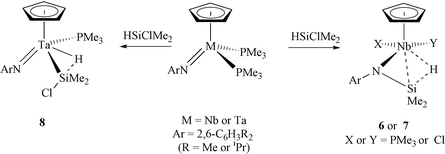Surprising diversity of non-classical silicon–hydrogen interactions in half-sandwich complexes of Nb and Ta: M–H ⋯ Si–Cl interligand hypervalent interaction (IHI) versus stretched and unstretched β-Si–H⋯M agostic bonding†
Abstract
Reaction of the niobium diphosphine compound [NbCp(NAr)(PMe3)2] (Ar = 2,6-C6H3Pri2) with HSiMe2Cl gives the formally d2 silylamido derivative [NbCp{η3-N(Ar)SiMe2-H}Cl(PMe3)] 6. X-Ray diffraction and NMR studies of this compound show that it has a stretched β-agostic Si–H → Nb interaction. Reaction of the related precursor [NbCp(NAr′)(PMe3)2] (Ar′ = 2,6-C6H3Me2) with HSiMe2Cl gives an isomeric structure [NbCp{η3-N(Ar′)SiMe2-H}(PMe3)(Cl)] 7 differing from 6 in that the phosphine rather than chloride lies trans to the co-ordinated Si–H bond. A preliminary X-ray study and large 1J(Si–H) coupling constant of 116 Hz suggest that this compound is best described as an unstretched β-agostic (Si–H⋯M) d2 silylamide complex. Reaction of the tantalum diphosphine compound [TaCp(NAr)(PMe3)2] with HSiMe2Cl affords the d0 silylhydride derivative [TaCp(NAr)(H)(SiMe2Cl)(PMe3)] 8 which, according to an X-ray diffraction study and NMR data, has an interligand hypervalent interaction (IHI) between the silyl and hydride ligands. Reactions of 6 and 8 with Me3SiX (X = I, OTf) lead to the corresponding iodido and triflate derivatives [NbCp{η3-N(Ar)SiMe2-H}X(PMe3)] (X = OTf 11 or I 12) and [TaCp(NAr)(H)(SiMe2X)(PMe3)] (X = OTf 14 or I 15). Reaction of 8 with AgOTf gives [TaCp(NAr)(PMe3)2Cl]OTf 13, the crystal structure of which has been determined. Density functional theory calculations on models of the compounds 6 and 7 showed that the experimental geometries are only correctly reproduced when the phosphine ligands are adequately modelled. The extent of oxidative addition of the Si–H bond to the metal in 6 mainly depends on the basicity of the phosphine ligand. With PH3 in place of PMe3 the calculated structures are better described as silanimine-hydrido derivatives. The formation of isomeric type 6versus7 is determined by an interplay of the steric and electronic effects of the ligand environment.


 Please wait while we load your content...
Please wait while we load your content...